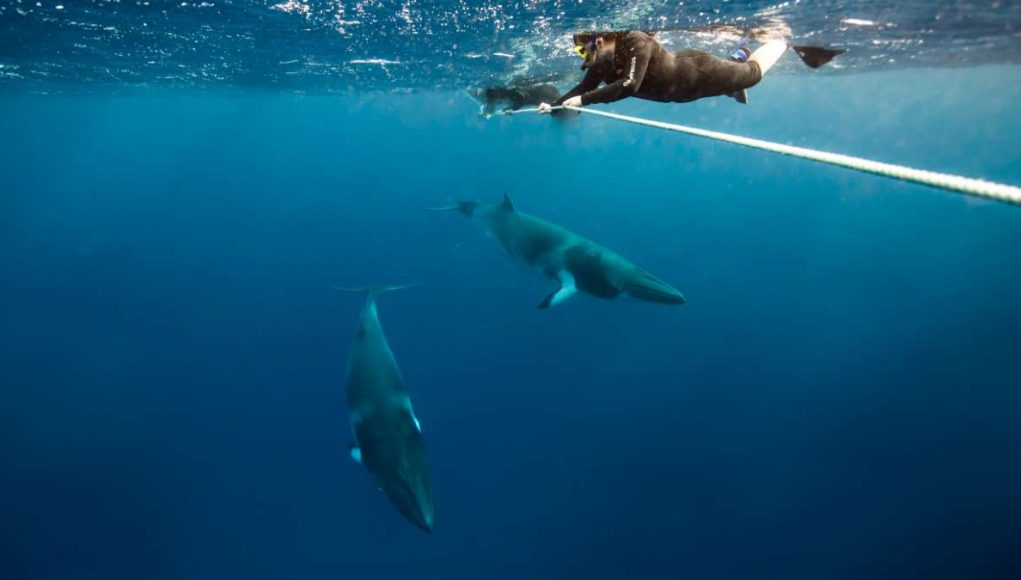In celebration of World Oceans Day on 8 June 2020, we take a look at some of Queensland’s most incredible marine life encounters and how your holiday can help safeguard our blue planet’s complex and diverse ecosystem.
From sharing photos of a shark’s pectoral fin to helping baby turtles make a dash for the ocean, there are plenty of options to make your marine life experience count:
DIVE WITH GREY NURSE SHARKS
Our world’s oceans are home to more than 400 shark species, and about 50 of them can be found along the Queensland coast. Among these is the grey nurse shark – one of Australia’s most endangered shark species with only 1,000 said to remain within the east Australian population.
Described as the ‘labradors of the ocean’, grey nurse sharks are typically harmless to humans. Those keen to get up close to the 3.5m long creatures, can do so all year around at Wolf Rock, off the coast of Rainbow Beach, just 2 hours north of Brisbane.
Overhanging ledges and vertical gutters, combined with warmer water temperatures and an abundance of marine life make this not only an ideal destination for multi-level diving, but a safe haven for endangered grey nurse sharks who come here to mate and breed.
The local dive operator – Wolf Rock Dive Centre – is committed to ensuring their daily tours have minimal impact on the species and its habitat by limiting group numbers to five divers, approaching animals respectfully, and other sustainable practises such as offering each diver their own drink bottle.
And by simply doing what we love most on holidays – taking photos – your dive can contribute to the ongoing research into grey nurse sharks. The shark’s pectoral fin acts like our fingerprint and by uploading your underwater photos to a database, researchers can identify the shark, map its movements, and extract information on the overall population of grey nurse sharks. This photo identification program is one part of ReefCheck Australia’s Grey Nurse Shark Watch program that Wolf Rock Dive proudly supports.
GET UP CLOSE TO HUMPBACK WHALES
It’s official. Hervey Bay is the world’s first Whale Heritage Site, making it the best place to responsibly see humpback whales.
Between July and November, 25,000 humpback whales migrate 10,000 kilometres from Antarctica to the warmer waters of the Whitsunday Islands to breed. On their return south, the whales bring their calves to Hervey Bay to relax and play, making it the winter whale watching capital of Australia.
In October last year, the World Cetacean Alliance has declared Hervey Bay the world’s first Whale Heritage Site in recognition of its responsible whale and dolphin watching. Backing this push was the crew of the Pacific Whale Foundation whose onboard scientists have led important whale research in this region since 1980.
To support the ongoing and vital research into whales, join the team of certified marine naturalists and scientists on board Pacific Whale Foundation’s rigid inflatable zodiac – the Ocean Defender – for a whale watching experience that makes a difference. Not only will you get to witness life on a bonafide research boat with all the thrills and intimacy that whale watching in these calm waters provides, but 100 percent of the profits from your tour booking will support the Oceania Foundation’s vital whale research in the region.
THE NEXT GENERATION OF TURTLES
While Queensland is home to six of the seven turtle species worldwide, population numbers are unfortunately dwindling. So, don’t just take a holiday to see them, but a holiday to safe them.
November to March is turtle nesting and hatchling season – the perfect time to join a Queensland Parks and Wildlife Service ranger-guided turtle encounter at Mon Repos Turtle Centre, near Bundaberg. Mon Repos beach supports the most significant population of endangered loggerhead turtles in the South Pacific and is also home to the country’s best educational centre for turtles. You can join their efforts to protect the species by signing up as a volunteer to help the rangers for the season.
Another great way to make your holiday count is to visit, donate to or volunteer at REEF HQ Aquarium in Townsville or the Cairns Turtle Rehabilitation Centre on Fitzroy Island. Visiting can be as hands-on as you want it to be and volunteering can see you doing anything from cleaning tanks to assisting turtle release back into their natural habitat.
EYE TO EYE WITH DWARF MINKE WHALES
For six very short weeks a year, only a few hundred people can claim to come face-to-face with dwarf minke whales as they congregate in the remote northern parts of Queensland’s Great Barrier Reef.
First documented in the mid-1980s, the Great Barrier Reef is the only place on the planet where tightly regulated permits allow adventurers to hold onto a rope and watch the underwater antics. Since then, swimming with minke whales has become one of the world’s best and longest wildlife encounters.
Eye to Eye Marine Encounters runs a tip top eco-tourism expedition to see dwarf minke whales, tiger sharks and green turtles through the Coral Sea and Outer Reef with an inherent message to preserve what is being watched.
Aside from all the sustainable practices in effect, Eye to Eye also reserve room for research scientists on all trips, which is funded through the expedition cost. This means you’ll be part of the science history in the making, joining these researchers as they conduct fieldwork on the trip. It’s a win, win situation!
SWIM WITH MANTA RAYS
The largest of all rays, mantas are like the birds of the ocean with their incredible wingspans of up to seven metres. Lady Elliot Island on the southernmost tip of Queensland’s Great Barrier Reef is billed as the home of the manta ray and was named by PADI as one of the ‘Top 5’ locations on the planet to dive with manta rays. It is also a world-leading ecotourism destination that stopped selling single-use plastic back in 2012, and offsets 100 percent of carbon emissions from flights to and from the island.
Manta rays can be regularly sighted throughout the year here, but winter is prime time. Budding scientists and eco warriors can submit their photos and videos of the underside of these graceful giants to Project Manta, a University of Queensland-led multidisciplinary study of the ecology and biology of manta rays.
Help from citizen scientists is vital for the project’s success in tracking and protecting two endangered species in Australian and Indonesian waters. The photographic evidence has helped reveal some of the mysteries of these magical creatures – where they eat, cruise and even visit ‘cleaning stations’ (where smaller fish exfoliate their dead skin and parasites). It found mantas are also more likely to gather under either a new or full moon.
JOIN THE CRUSADE
Feeling inspired? For more ways on how your Queensland holiday can help protect and sustain our blue planet’s incredible ecosystem, visit queensland.com.






